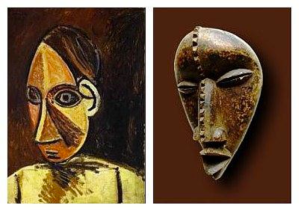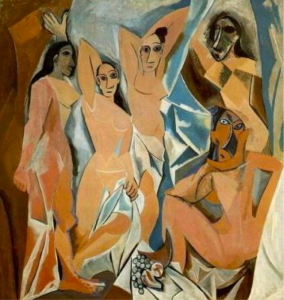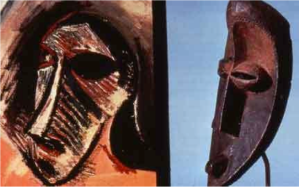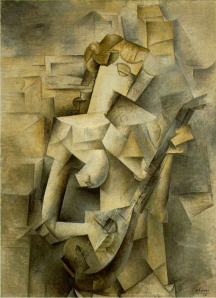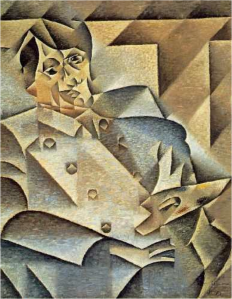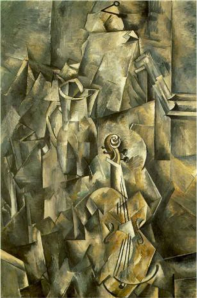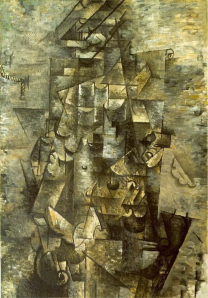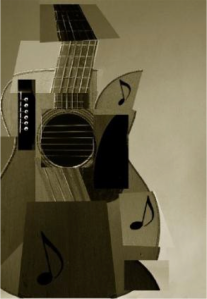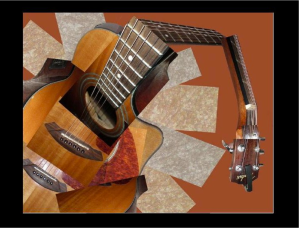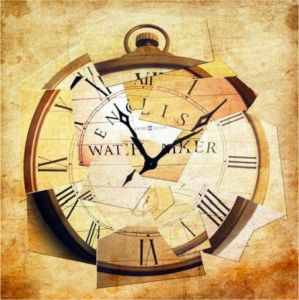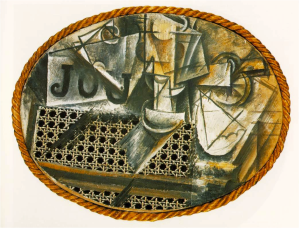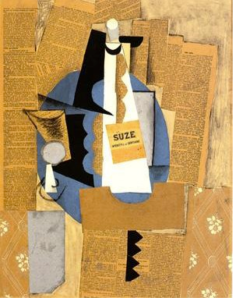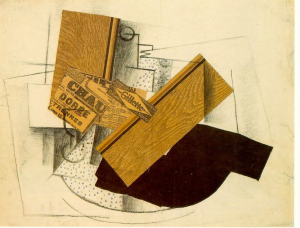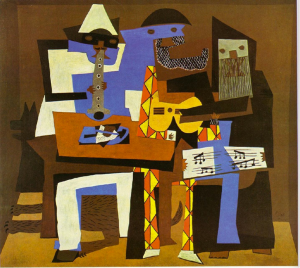Spend some time reading through this information on Cubism. It is designed to give you a clearer overview of the movement and how it originated.
Deconstruction
Guiding Question- How do artists manipulate the real world to create abstract art?
Cubism a Fractured Reality
YOU will
1. Gain an understanding and awareness for the cubist style of artists such as Picasso, Braque, and Gris.
2. Create a composition showing multiple views of various objects — fracturing the planes in the manner of the cubists
3. Create a composition with a variety of textures – developing interest through contrast and possibly added collage elements.
Cubism
Cubism was developed between about 1908 and 1912 in a collaboration between Georges Braque and Pablo Picasso. Their main influences are said to have been Tribal Art and the work of Paul Cezanne. The movement itself was not long-lived or widespread, but it began an immense creative explosion which resonated through all of 20th century art.
PAUL CÉZANNE (1839-1906), Post-Impressionist artist
‘Bibemus Quarry’, 1895 (oil on canvas)
The influence of Paul Cezanne
How the houses and roads are being distorted with artist’s concept of disregarding the physical laws of nature?
What major form or shapes are left in the painting? Can we still identitify the objects?
The Influence of African Art
The Cubists believed that the traditions of Western art had become exhausted and another remedy they applied to revitalize their work was to draw on the expressive energy of art from other cultures, especially African art.
In the early 20th century, artists began to question the inner purpose and meaning of art while science was questioning the inner meaning of nature. The key concept underlying Cubism is that the essence of an object can only be captured by showing it from multiple points of view.
Cubism had run its course by the end of World War I, but among the movements directly influenced by it were Futurism, Purism, Constructivism, and, to some degree, Expressionism.
Can you describe the elements of the work? What are they?
Analytical cubism: Mapping Reality
Analytical cubism occurred between 1910 to1912 and combines artistic savagery and the ‘legacy of reducing reality to basic geometrical shapes that are clearly connected with one another.’ It was used to break down the surface of objects being represented into basic, geometric shapes. Through this concept, a single image was formed from a multiplicity of small ‘perceptions grasped by the body in movement.’ Essentially, the term analytical cubism has been coined because of its dissection of its subject matter. By creating a geometric structure of overlapping, shifting and tilted cubes, a work is created that seems to project out of the picture plane. Instead of a single-point linear perspective, the scene changes when viewed from various positions. Other features of analytical cubism include a simplified palette of colors (using earth tones mainly) and the density of the image residing at the center of the canvas. Overall, analytical cubism allowed the canvas to become a screen onto which images are projected, as it is transformed from a static record to a ‘dynamic vision akin to moving pictures.’
Views from different angels to create a dynamic vision (face).
Colors are subtle and not colorful to let audience to focus on the broken shapes
Lacks elements of light, atmosphere, and space.
Gave depth and richness to painting.
Overlapping Fragments
Reality of objects in space, reality of flat painted surface.
What kind of still life objects are there?
How could these objects be viewed and represented in another way?
Example of how we perceive a guitar with multiple viewpoints through use of photography
What techniques have they used to show the concept of Cubism?
See how background and object planes intersect one another to create the shallow ambiguous space, one of cubism’s distinct characteristics.
How does overlapping and shifting picture planes allow them to work with each other?
Styles and Techniques
Synthetic cubism: Vision of Modern Urban Life’
It occurred between 1912 to 1914 and was assembled out of separate parts of new forms. This phase integrated elements of collage to recreate how ‘modern urban street life appears to the onlooker.’ This involved the introduction of different textures, surfaces and merged subject matter including newspapers, text, posters and music scores.
Techniques
Synthetic cubism placed an emphasis on multiple layers and shapes, creating compositions that were simpler, brighter and bolder then analytical cubism, with less shading to create flatter space and fewer plane shifts. This was achieved by bringing together familiar ‘scraps’ and unfamiliar forms, to produce a sense of urban life and allowing ‘low art’ to become ‘high art.’
How did Picasso create interest through value contrast, various textures and collage elements?
How did Picasso use colors to create a variety of light & shadows?
What collage elements have been used in this synthetic style cubist painting?
What collage elements have been used in this synthetic style cubist painting?
Newspaper, magazines and labels were used in this work
- Wider use of color
- Appealing and easy to interpret
- Less intricate
- Added substances like sand to paint to make it appear thicker
Overall Characteristics
• Reject that art should copy nature
• Reject use of traditional techniques
• Emphasize two-dimensionality (geometricity)
• Reduce objects to geometric shapes and put these within a shallow space
• Multiple/contrasting viewpoints
• Overlapping planes
• Exploration of the fourth dimension
Cubism consisted of two stages
• Analytical- Very abstract; mostly made up of overlapping planes and geometrical figures
• Synthetic- tended to use new mediums, such as clips from newspaper on top of painted canvas; took away all three dimensional aspects left in Analytical Cubism
Analytic vs. Synthetic
• Based on intellect but not emotional
• Monochromatic color palette
• Reduces object to basic geometric shapes
• Linear construction
Synthetic
• Less intricate
• More color
• More appealing
• Collage
• Objects less recognizable
• Less shading
• Added substance to paint (e.g. sand)
Conclusion
- Picasso, Gris, and Braque are the three main Cubists
- African art, Gauguin, and Cezanne are major influences
- Simplified objects cut down into geometric shapes and shown from different angles and planes
- Two major phases, analytic and synthetic.

